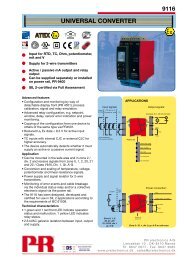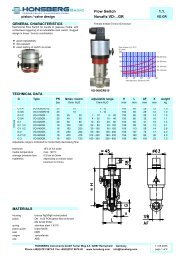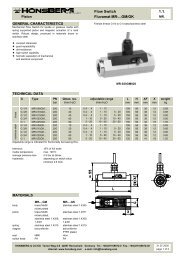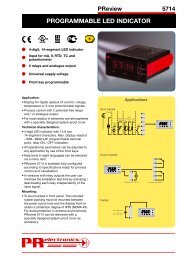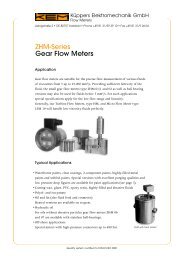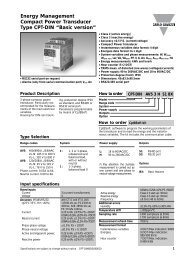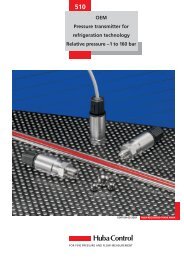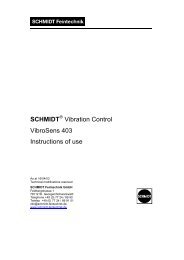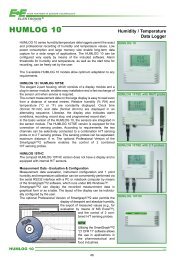Proximity Sensors Capacitive Thermoplastic Polyester Housing ...
Proximity Sensors Capacitive Thermoplastic Polyester Housing ...
Proximity Sensors Capacitive Thermoplastic Polyester Housing ...
Create successful ePaper yourself
Turn your PDF publications into a flip-book with our unique Google optimized e-Paper software.
EC, M30, DC<br />
Dimensions<br />
C<br />
D<br />
E<br />
C<br />
D<br />
E<br />
B<br />
B<br />
Cable<br />
F<br />
SW<br />
A<br />
LED<br />
Plug<br />
SW<br />
A<br />
LED<br />
M12x1<br />
Type A B C D E F SW<br />
Ø mm mm mm mm mm mm<br />
EC 3016xPAPL(-1) M 30 x 1.5 x 50 28 50 13.6 15.4 10 36<br />
EC 3025xPAPL(-1) M 30 x 1.5 x 50 28 62 13.6 15.4 10 36<br />
Wiring Diagrams<br />
1 BN<br />
1 BN<br />
4 BK<br />
2 WH<br />
2 WH<br />
4 BK<br />
3 BU<br />
NPN<br />
3 BU<br />
PNP<br />
Adjustment Guide<br />
The environments in which<br />
capacitive sensors are installed<br />
can often be unstable regarding<br />
temperature, humidity,<br />
object distance and industrial<br />
(noise) interference. Because<br />
of this, Carlo Gavazzi offers as<br />
standard features in all TRIP-<br />
LESHIELD capacitive sensors<br />
a user-friendly sensitivity<br />
adjustment instead of having<br />
a fixed sensing range, extended<br />
sensing range to accommodate<br />
mechanically demanding<br />
areas, temperature stability<br />
to ensure minimum need for<br />
adjusting sensitivity if temperature<br />
varies and high immunity<br />
to electromagnetic interference<br />
(EMI).<br />
Note:<br />
<strong>Sensors</strong> are factory set (default)<br />
to maximum rated sensing<br />
range.<br />
EC3016xPAPL(-1)<br />
EC3025xPAPL(-1)<br />
Sensitivity<br />
Adjustment<br />
(4-wire device backview)<br />
Max.<br />
Sensitivity<br />
Min.<br />
Dist.<br />
Tripleshield<br />
Installation Hints<br />
<strong>Capacitive</strong> sensors have the<br />
unique ability to detect almost<br />
all materials, either in liquid or<br />
solid form. <strong>Capacitive</strong> sensors<br />
can detect metallic as<br />
well as non-metallic objects,<br />
however, their traditional use<br />
is for non-metallic materials<br />
such as:<br />
• Plastic Industry<br />
Resins, regrinds or moulded<br />
products.<br />
• Chemical Industry<br />
Cleansers, fertilisers, liquid<br />
soaps, corrosives and<br />
petrochemicals.<br />
• Wood Industry<br />
Saw dust, paper products,<br />
door and window frames.<br />
• Ceramic & Glass<br />
Industry<br />
Raw material, clay or finished<br />
products, bottles.<br />
• Packaging Industry<br />
Package inspection for<br />
level or contents, dry<br />
goods, fruits and vegetables,<br />
dairy products.<br />
Materials are detected due to<br />
their dielectric constant. The<br />
bigger the size of an object, the<br />
higher the density of material,<br />
the better or easier it is to detect<br />
the object. Nominal sensing<br />
distance for a capacitive<br />
sensor is referenced to a<br />
grounded metal plate (ST37).<br />
For additional information regarding<br />
dielectric ratings of<br />
materials please refer to<br />
Technical Information.<br />
2 Specifications are subject to change without notice (20.08.01)



